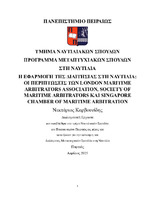Η εφαρμογή της διαιτησίας στη ναυτιλία : οι περιπτώσεις των London Maritime Arbitrators Association, Society of Maritime Arbitrators και Singapore Chamber of Maritime Arbitration
The deployment of arbitration in shipping : the cases of the London Maritime Arbitrators Association, Society of Maritime Arbitrators and Singapore Chamber of Maritime Arbitration

View/
Keywords
Διαιτητικά forums ; Μηχανισμός επίλυσης διαφορών ; Ναυτική διαιτησία ; ΝαυτιλίαAbstract
This thesis explores the application of arbitration in shipping with a particular focus on the cases of the London Maritime Arbitrators Association, Society of Maritime Arbitrators and Singapore Chamber of Maritime Arbitration. The research question of this thesis is what similarities and differences are found, among others, between the three aforementioned cases. The hypothesis of this scientific study is that the general advantages of arbitration as a mechanism for alternative and out-of-court dispute resolution, some of which are recognized in all three above-mentioned arbitration forums in the maritime industry, have several times resulted in this fundamental mechanism being preferred by the parties over the method of traditional recourse to the courts. Initially, the first part reviews the theoretical background underlying arbitration, including maritime arbitration. The second part of this scientific study then focuses on maritime transport and maritime salvage, which are among the most important transactional aspects of shipping. In the third part of this thesis, the case of the London Maritime Arbitrators Association is analyzed. First, we mention some general facts about the particular association, its members and the pros and cons of its selection and then focus on its established rules for maritime arbitration, on arbitration cases governed by these rules, as well as on the maritime arbitration costs of this association. In Part Four, which deals with the Society of Maritime Arbitrators, is also preceded by a presentation of some general information about the specific arbitral forum, the members and advantages of this forum followed by a detailed reference to its rules for maritime arbitration and the citation of illustrative maritime arbitration cases based on these rules, as well as the cost of maritime arbitration of the above-mentioned institute. Finally, the fifth part concentrates on the Singapore Chamber of Maritime Arbitration. Nor does this case fail to note first some opening remarks about this chamber before our analysis focuses on its rules for conducting maritime arbitration, illustrative maritime arbitration cases under these rules, as well as the maritime arbitration costs of this chamber.


